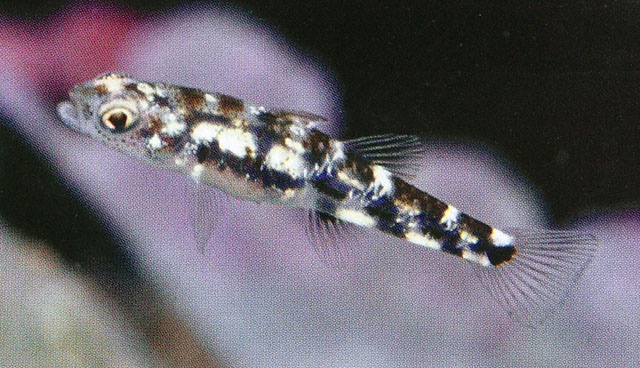| Gobiidae (Gobies), subfamily: Gobionellinae |
| 1.1 cm SL (male/unsexed); 1.5 cm TL (female) |
|
demersal; freshwater; brackish; marine; pH range: 7 - 8.39999961853027; dH range: 30; depth range 0 - 2 m, amphidromous |
| Asia: Indonesia and Philippines. Originally reported from the Malabon River, Rizal, Philippines, which has meanwhile been reclaimed. According to Ref. 6216 it has also been collected in the sea at Culion Island, off Palawan, Philippines. Recently collected in Bali (1991), Sulawesi (1988), and Singapore (1992), M. Kottelat, pers. comm. |
|
Dorsal spines (total): 7-7; Dorsal soft rays (total): 6-7; Anal spines: 1-1; Anal soft rays: 6-7. Dark spots on sides of body somewhat forming 4 cross-bands; heavy pigmentations on all bases of fins, except ventrals, apparently are continuation of body pigmentation. Head and nape naked. 22 to 25 scales in longitudinal series (Ref. 4924); further characterized by presence of black spot at middle of caudal fin base; first dorsal fin yellowish with black anterior; rounded caudal fin (Ref. 90102). |
| This is one of the smallest freshwater fishes: males are mature at 9 mm, females at 15 mm. The species used to frequent shady river banks in the Malabon River, Rizal Province, Luzon, Philippines; however, the type locality has been reclaimed and the remaining waters in the area are heavily polluted; the species is considered extinct in the Philippines (Rainer Froese, pers. comm., 2004). It has been apparently imported into Germany in 1958; a color photo of the fish was taken in an aquarium (Ref. 2060). Found in brackish waters and mangrove areas of Indonesia (M. Kottelat, pers. comm.). |
|
Data deficient (DD); Date assessed: 14 October 2020 Ref. (130435)
|
| harmless |
Source and more info: www.fishbase.org. For personal, classroom, and other internal use only. Not for publication.
